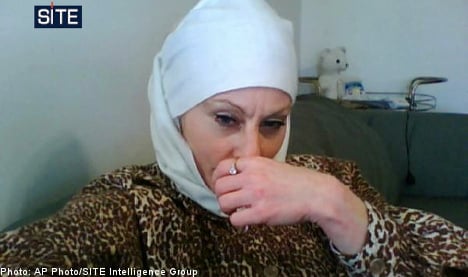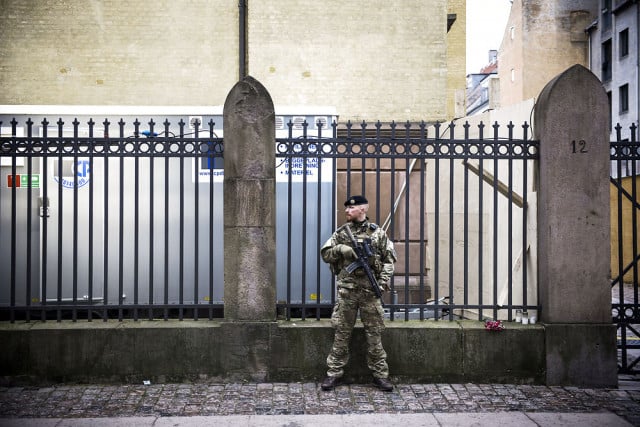The woman, who is in her 40s and is named as Colleen LaRose was arrested in October 2009 but news of her indictment was made known only hours after the arrest of seven alleged jihadists in Ireland on Tuesday.
Over the course of at least a year, LaRose is alleged to have used the internet to recruit men in South Asia, Europe and the United States for terror attacks.
As part of these preparations Jihad Jane, as is her internet alias, travelled to Sweden in August, a federal US official told the Washington Post.
According to the newspaper, LaRose was interviewed by the FBI in July but denied then that she was in contact with any terrorist groups.
Before her trip to Sweden she is reported to have removed the hard disk from her PC and hidden it. Later the same day she travelled to Sweden to live with and train with jihadis, as well as find and kill her target, Lars Vilks, the newspaper writes.
But the woman instead returned to the USA and was arrested on her arrival in Philadelphia on October 15th 2009.
According to American media, the 40-year-old had internet contact with at least one of the seven people arrested in Ireland.
The connection between Jihad Jane and the seven, four men and three women, has been confirmed by two US officials to The Philadelphia Enquirer and by a spokesperson for the Irish police to news agency TT. The nature of the link is not yet known.
According to the charges in her indictment published on Tuesday, Colleen LaRose is suspected of “conspiracy to provide material support to terrorists, conspiracy to kill in a foreign country, making false statements to a government official and attempted identity theft.”
Swedish prime minister Fredrik Reinfeldt commented on Wednesday on the suspected murder plans against Vilks by saying that “there is every reason to take this seriously if there had been plot of this nature.”
Lars Vilks was meanwhile taking the attention in his stride on Wednesday.
“I see this as a repetition of the events of 2007 and this will probably happen a couple more times. With a little luck and caution I’ll survive,” he said.
Leading Swedish newspapers on Wednesday published the cartoon at the centre of the drama – depicting the Islamic prophet Muhammad with the body of a dog.
Sweden’s paper of reference Dagens Nyheter published the controversial drawing for the fourth time, insisting artist Lars Vilks “is not alone in this conflict.”
“A threat against him is, ultimately, a threat against all Swedish people,” the paper said in an editorial and called on the Swedish state to give Vilks “all the protection he needs.”
It said authorities must take action “against an attack aimed at one of our most fundamental rights, freedom of expression.”
The Expressen tabloid also published the cartoon, insisting it was important “to defend freedom of expression which is more and more threatened.”
“An open society must show that it will not give in to threats, that it is ready to fight for freedom of expression,” added the daily in an editorial.
The regional daily Nerikes Allehanda started the controversy when it first published Vilks’ satirical cartoon on August 18th 2007 to illustrate an editorial on the importance of freedom of expression.
That paper did not choose to republish the drawing on Wednesday.
“I don’t think it is relevant to publish the picture,” Nerikes Allehanda’s chief editor Ulf Johansson, who has also faced threats over the initial publication, wrote in the paper.
“If I were to publish it, it would have another symbolical value than when other papers publish it. Dagens Nyheter has published the picture three to four times already and no one has cared,” he added.
The Aftonbladet tabloid, which published the drawing in 2007, also refrained from republishing it Wednesday, with chief editor Jan Helin insisting “the picture has no news value today.”
“Publishing the same picture now would … only increase the level of conflict and provocation in a situation that requires enlightenment, discussion,” he wrote.
Vilks showed no remorse on Tuesday, telling the TV4 commercial broadcaster that he would consider doing it all over again “if the occasion was right.”
“One is allowed to insult all religions but not Islam. That is the exception. There is a problem there,” he said.
Social Democrat politician Nalin Pekgul has meanwhile criticised Vilks and his cartoon, arguing that instead of aiding freedom of speech he had in fact “weakened” Muslims fighting for democracy and democratic values, and played into the hands of the extremists.
“For me an artist is someone that fights upwards, against the powers-that-be. Not downwards at a group that is already on the ground,” Pekgul told TV4.
Pekgul, who is a Muslim with Kurdish-Turkish roots, told of how she was personally insulted by Vilks’ cartoon when it was published in 2007.
“In the Muslim part of the world the dog is unclean, it is not even allowed to come in the house. To draw Muhammad as a dog is indescribably hurtful,” she said.
Pekgul argued that is wrong to lump all Muslims together as extremists if they object to Vilks’ illustrations, but she thinks that the cartoons give the extremists a useful argument with which to recruit young European Muslim’s to fundamentalism.
The threat against Vilks has its parallel in neighbouring Denmark, where several plots to murder cartoonist Kurt Westergaard have been foiled since his drawing of
Muhammad with a turban in the shape of a bomb was first published in September 2005, along with 11 other drawings focused on Islam.
The threat against Vilks “is very sad, I think,” Westergaard told Expressen on Wednesday.
“But I am impressed by his courage and that he refuses to give in,” he said.




 Please whitelist us to continue reading.
Please whitelist us to continue reading.